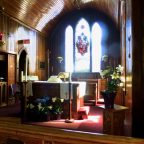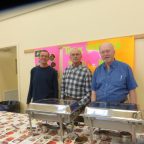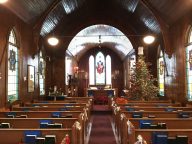Reclaiming the Power of Lament
Rev. Dr. Yme Woensdregt
Last week, I wrote that life is going to hurt. There are so many ways in which we try to deny the power of that hurt, but I suggested that a healthier response is to learn to suffer well.
This week, let me take the same subject in a more global direction. Life hurts, certainly, on an individual level. It is also true to say that many people are hurting in our world. We need only begin to name the cities: Baltimore; Charleston; Quebec City; Paris; Berlin. Tragedy seems to be increasing in our world. The last few weeks, months and years have seen an outbreak of hatred and prejudice and bigotry around the world. We are being bombarded on every hand by the pain and brokenness in our society and around the world.
Dominique Gilliard, a pastor in California is also the director of racial reconciliation pilgrimages for his denomination. Part of his life’s mission is to act on the need for racial reconciliation, not only in the USA but also in Canada.
In light of his work in reconciliation, he states boldly that learning to lament is an essential and even revolutionary act. He asserts that the church needs desperately to reclaim this as a spiritual practice.
Lamentation, says Gilliard, is the first step in reconciliation. “When we lament, we confess our humanity and concede that we are too weak to combat the world’s powers, principalities and spiritual wickedness on our own. When we lament, we declare that only God has the power to truly mend the world’s pain and brokenness.”
To lament is a spiritual practice. In a time when it seems as if one tragedy follows another without ceasing, we are in danger of overload. Gilliard continues, “Lamentation forces us to slow down. It summons us to immerse ourselves in the pain and despair of the world, of our communities…”
Slowing down like this is a way of learning to suffer well. We notice where we hurt. We take time to notice where our world is in pain. We notice the pain so that we can engage with it, and in doing so, we can move on to dealing with it.
We notice, we lament, and we find that “Lamentation prevents us from becoming numb and apathetic to the pain of our world and of” the people around us.
Gilliard suggests that “lamentation requires four steps: remembrance, reflection, confession and repentance.”
We remember. We counter our natural tendency to run away from the pain. We remember the innocent who were harmed. We hold them up in prayer and in thought, and we honour their memory.
We also remember the one who is responsible for causing the pain. We remember that we and they share a common humanity. We don’t write the perpetrator off. We remember.
We reflect. We seek to find a deeper context as we try to understand why this act occurred, why this pain was caused, why these people were hurt.
We reflect as individuals. We also reflect in community with others. This is why acts of keeping vigil become so important. People gather together to remember and reflect. People lament together, supporting one another in our pain and confusion.
We confess. Confession is not a popular word. It never has been. It’s hard to admit that we have both harmed someone and been harmed by someone. It is painful to say to another that we were wrong. It is a difficult thing to acknowledge that we live in a society in which hatred and fear seem to kindle more hatred and fear.
Confession is more than acknowledging that we have done something wrong. Confession also recognizes that the work of reconciliation is hard. We confess our inability to do it alone, and we seek to work with others.
We repent. To repent doesn’t mean to be sorry. It doesn’t even mean to be really, really sorry. To repent means to turn around, to see the wonder and beauty in life and live in ways that honour that wonder. We choose to walk in a different direction, to live with grace and compassion, to seize the initiative to live in ways that seek to heal rather than to destroy.
It strikes me that this is the work which the Truth and Reconciliation Commission recommended to Canada as a way of healing our relationship with aboriginal peoples.
We remember the Residential Schools. We reflect on the harm that was done. We confess our participation in that harm. We repent and choose to walk in partnership with our indigenous brothers and sisters.
There is great power and wisdom in the practice of lamentation. It has the potential to heal us as individuals. It has the potential to heal our society.
It is completely counter–cultural … but that strikes me as a good thing, because our culture as it is now is dominated by greed, acquisitiveness, and fear. It is time to seek another way—the way of lament. The way of remembering. The way of reflecting. The way of confession. The way of repentance.
From Epiphany to Lent
Today is Transfiguration Sunday.
So what?
It’s hard to know what to do with Transfiguration Sunday. It’s not as if it’s a common word in our everyday speech. What does it even mean?
The Greek root behind “transfiguration” is the word “metamorphosis”. For a moment, Jesus is changed. Here on the mountaintop, we catch a glimpse of Jesus in all his glory.
And because we are dealing with holy glory, we are dealing with mystery. God’s holiness comes crashing into a broken and hurting world.
Jesus takes Peter, James and John up a high mountain—which is a symbol of God’s presence; you’re closer to heaven at the top. At the top, Jesus changes. He shines with a light so bright they can barely stand it. Jesus is dazzling, shining with the radiance of God.
Suddenly Moses and Elijah appear, talking with Jesus. These two holy men of the Old Testament reveal that in Jesus, the Law and the Prophets have come together. Jesus inaugurates a new creation. God is doing something new.
Peter wants to hold on to the moment, to build a shrine. He wants to stay on the mountaintop, in the presence of this glory. Who can blame him?
A bright cloud envelopes the three holy men. The cloud is another symbol of God. A voice speaks, echoing the words we first heard when Jesus was baptized: “This is my Son, chosen and marked by my love. Listen to him.”
The disciples fall to the ground, scared out of their wits. But Jesus touches them, and whispers words we hear over and over again in the Bible: “Don’t be afraid.” They open their eyes and see only Jesus.
At the very end of this mysterious episode, Jesus tells them: “Don’t tell anyone about this. After the Son of Man has been raised from the dead, then you can tell everyone. Get up.” These words only deepen the mystery.
They come down from the mountain. They begin the journey which leads to Jerusalem, which leads to the cross.
I want to focus on two things.
First of all, this story is a turning point in the gospel. Just before this, Jesus has told his disciples that they must go to Jerusalem, where he will suffer and be executed. Jesus tells his disciples in every age that if we want to follow, we will have to take up our crosses and follow.
Immediately following this scene, Jesus and the disciples begin their journey to Jerusalem. Jesus’ teaching becomes more pointed and there is increasing conflict with the authorities.
So, what happens in this scene is that the story stops for a moment. Just before the conflict escalates, just before Jesus begins his journey to the cross, we catch a glimpse of God’s glory.
Transfiguration Sunday functions the same way in the Church Year. Today is a hinge between Epiphany and Lent.
Epiphany is a season to reflect together about who Jesus is. We received the wondrous gift of God’s presence at Christmas, and we spend the season of Epiphany unwrapping that gift and discovering the wonder of God’s love in it.
We were there when Jesus was baptized. We heard this same voice telling us, “This is my boy. I delight in him.” Then, week by week, we listened as Jesus taught us what it means to live as citizens of the kingdom of God. Paul taught us that if we want to see who Jesus is, we need to look to the cross. God comes to us not in our own strength, but precisely in our weakness. God comes to us in our brokenness so that we might reach out to love and heal.
This Wednesday, we will enter Lent. We will reflect together on what it means to us to be followers of this Jesus. What does it mean to be Christian? How important is it to us to be known as followers of Jesus? How do we live that out in our daily lives?
Transfiguration is the hinge between those two seasons. We end up on the mountaintop, and like Peter, we would just as soon stay there. But we can’t.
Jesus leads us off the mountain into our neighbourhoods. He leads us into a broken world, because that’s where so many of our sisters and brothers live. We find our ministry at the bottom of the mountain, in the cities, in the valleys, in our neighbourhoods. We go down the mountain to work in partnership with God for the healing of the world.
And that’s where our transfiguration happens. God’s glory shines in us as we work with those who are broken. God’s radiance shines through us as we reach out in love and compassion. God’s hope blazes through us as our lives reflect the love of God in everything we do.
On Transfiguration Sunday, we move from Epiphany to Lent. We journey from learning who Christ is to reflecting on who we are as followers of Jesus.
That’s one thing.
The other thing I want to reflect on is a thought I gleaned from Alfred North Whitehead, who remarked that the aim of the universe, the aim of God, is to produce beauty.
For me, that’s an awe–inspiring thought. God’s purpose is to produce beauty.
For Whitehead, beauty is not just a nice feeling or a pretty landscape. Beauty is a deeply religious emotion that issues in ethical action. Beauty moves us to do the work of healing and compassion and grace and hope.
To be moral, therefore, is to produce beauty, is to make the world more beautiful.
Let me give you an example. Last night, I volunteered with the Coldest Night of the Year walk, raising funds for the Homeless Coalition. I was a the Hot Shots Café … not in the café, understand, but outside it, guiding people in or on to the next leg of the walk. It was cold, and the wind was bitter. About an hour in, I started to grumble to myself. What are you doing here? Why are you standing out in the cold like this? Why don’t you go home and get warm?
Then a little girl came around the corner. She saw me, and ran to me, calling my name—“Yyyyyyymmmeeeeeee.” She wrapped her hands around my legs and looked up at me, grinning from ear to ear, and said, “Isn’t this funnnnnnnnnn?”
Something shifted in me. Beauty was created in me. I was doing something valuable, something worthwhile, something critically important for our city. In that moment, in that little girl, I saw God, and God created something beautiful in me. The gospel came alive.
I think that’s what Whitehead is talking about. At the heart of this transfiguration story, for just a brief shining moment, we catch a glimpse of beauty. For a heartbeat, we lose ourselves in a moment of ecstasy. Our eyes are opened, and we see deep into the beautiful heart of creation as God intends it to be.
It seems as if our lives are often too busy for beauty. Some have suggested that we have lost our capacity for wonder. We are oblivious to wonder and beauty as we try to satisfy our hunger to consume. We lose ourselves in tweeting, and we miss the wonder of life as it passes by us. We don’t have time to marvel at a baby’s birth, a child’s laugh, photos of new planets, a whale breeching, a bird in flight. We use life instead of marveling at it. We use the earth as if it exists for our benefit alone; and Pope Francis reminds us that we have ended up making the earth a garbage dump.
One preacher tells a story about his oldest son. “My seven–year–old is a science guy. My wife and I, not so much. One day my wife and our two sons were fishing in a little pond. The sun was setting and the western sky was full of colors; red, purple, orange. Our four–year–old asked, ‘What makes the sky so pretty?’ Mom answered something about God creating natural beauty for our enjoyment and to remind us of the presence of the holy in the world around us. The seven–year–old says, ‘Well, Mom, actually it’s just the sun reflecting off dust particles and moisture in the atmosphere.’
There’s nothing wrong with being a science guy. But have we lost our capacity to wonder? Celtic Christians talk about “thin places” where God is juuusssttt there … we can almost reach out and touch. Have we lost any sense of that place, that moment, where heaven and earth almost meet?
Alfred North Whitehead affirms that God’s purposes move towards producing beauty. In transfiguration, heaven and earth come together. God’s grandeur shines. We move into Lent with this moment of wonder, this moment of beauty to sustain us.
The English poet Gerard Manley Hopkins says, “the world is charged with the grandeur of God.”
So are we. We are charged with the grandeur of God. God’s beauty moves in us, and through us, and we are transfigured with grace and compassion as we move into Lent.
Thanks be to God.
Rev. Dr. Yme Woensdregt
February 26, 2017
Last Sunday after Epiphany (Sunday of the Transfiguration)
Matthew 17: 1–9
2 Peter 1: 16–21
Exodus 24: 12–18







